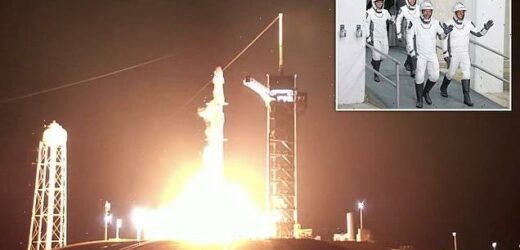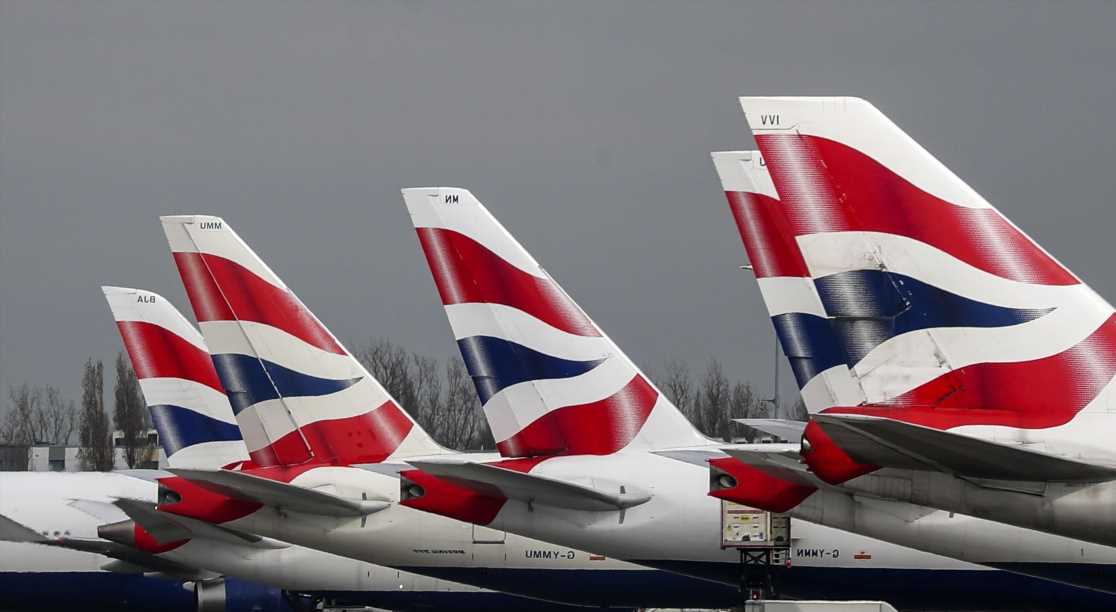Lift off! SpaceX launches crew of NASA and ESA astronauts to the International Space Station – less than two days after returning millionaire ‘space tourists’ safely to Earth
- The Crew-4 mission blasted off from the Kennedy Space Center at 03:52 EST (08:52 BST)
- It includes NASA astronauts Kjell Lindgren, Bob Hines and Jessica Watkins, and ESA’s Samantha Cristoforetti
- Jessica Watkins is the first black woman to join the crew of the ISS on an extended mission
- The crew have named their new SpaceX Crew Dragon capsule ‘Freedom’ in honour of Alan Shepard
SpaceX launched four astronauts to the International Space Station for NASA on Wednesday, less than two days after completing a flight chartered by millionaires.
It’s the first NASA crew comprised equally of men and women, including the first black woman making a long-term spaceflight, Jessica Watkins.
‘This is one of the most diversified, I think, crews that we’ve had in a really, really long time,’ NASA’s space operations mission chief Kathy Lueders said on the eve of launch.
The Crew-4 mission blasted off from the Kennedy Space Center – aboard a Crew Dragon capsule named ‘freedom’ after the first American in space, Alan Shepard – at 03:52 EST (08:52 BST).
It will arrive at the space station at 20:15 EST Wednesday (01:15 BST Thursday) , with the hatch set to open at 21:45 EST.
The crew, including Americans Kjell Lindgren, Bob Hines and Jessica Watkins, and Italian Samantha Cristoforetti of the European Space Agency, will spend five months carrying out scientific experiments at the orbiting lab.
The Crew-4 mission blasted off from the Kennedy Space Center at 3:52 am (08:52 BST) and will arrive at the space station at 8:15 pm Wednesday (01:15 BST Thursday)
Crew of first private flight to ISS return to Earth
Three wealthy businessmen and a former NASA astronaut splashed down Monday off the Florida coast after spending more than two weeks aboard the International Space Station, in a landmark mission for the commercial sector.
After a dizzying descent, a SpaceX Dragon capsule carrying the Axiom-1 gently floated down to the Atlantic Ocean near Jacksonville at 13:06 EST (18:06 BST) on four huge parachutes.
The spaceship was affectionately referred to as a ‘toasted marshmallow’ because of the scorch marks on its heat shield from re-entering the atmosphere at 17,500 miles per hour.
The crew was quickly retrieved by a waiting ship, marking the official end of the first fully private mission to the orbiting outpost – and a turning point in US space agency NASA’s goal to commercialise the region of space called low Earth orbit (LEO).
The rapid turnaround time for SpaceX – a little under 40 hours between recovering one crew and sending up another – is a sign of an increasingly busy human spaceflight calendar since Elon Musk’s company became NASA’s mainstay astronaut taxi in 2020.
Between 2011 – when the Space Shuttle program ended – and 2020, NASA was reliant on Russian Soyuz rockets for the service.
‘Think how the Cape has transformed, think about all of those abandoned launchpads on the Cape, and how they are roaring back to life,’ NASA Administrator Bill Nelson said in a press call on Tuesday.
Crew-4 was originally due to launch last weekend, but had been delayed due to the Ax-1 commercial crew mission, carrying three wealthy businessmen who each paid $55 million (£41 million) to take part in the trip.
Ax-1 had to return to Earth before Crew-4 could launch, as its spacecraft was occupying the same docking port on the ISS that was needed for Freedom.
Canadian investor Mark Pathy, US entrepreneur Larry Connor, ex-Israeli Air Force pilot Eytan Stibbe and retired astronaut Michael López-Alegría had been due to spend eight days carrying out scientific experiments on the space station.
But bad weather repeatedly delayed their departure, meaning they actually worked alongside the seven regular, government-paid crew for a total of 16 days.
Their SpaceX capsule eventually touched down off the coast of Florida at 5pm BST (12pm EST) on Monday, 25 April.
Crew-4 was originally due to launch last weekend, but had been delayed due to the Ax-1 commercial crew mission, which couldn’t depart the ISS due to bad weather
On arrival, Crew-4 will join the Crew-3 quartet, who are approaching the end of their five-month rotation on the ISS, as well as three Russians on the Russian segment of the orbital outpost.
A date for Crew-3’s return will be set soon.
Crew-4 is due to carry out hundreds of scientific experiments, including ongoing research into growing plants without soil in space.
Another involves developing an artificial human retina, leveraging the microgravity environment of the ISS to help deposit layer after layer of thin films of protein.
The technology ‘could eventually be used to replace damaged photoreceptor cells in the eyes and potentially restore meaningful vision to the millions of people who suffer from retinal degenerative disease,’ said NASA scientist Heidi Parris.
Among the crewmates, Watkins is only the fifth Black woman to go to space, and the first to join the crew of the ISS on an extended mission.
Crew-4 mission astronauts (from L) Bob Hines, Kjell Lindgren, Jessica Watkins and Samantha Cristoforetti of the European Space Agency walk out of the Neil A. Armstrong Operations and Checkout Building en route to launch complex 39A at the Kennedy Space Center in Florida
Crew-4 mission astronauts including Jessica Watkins (L) and Bob Hines (2nd L) have an impromptu cheer to the success of their mission
This is the fifth crewed spaceflight SpaceX has operated for NASA – after test flight Demo-2 and the three operational missions to the ISS in a Crew Dragon.
Overall, this is the seventh Crew Dragon flight, with one taking the fully-private Inspiration4 crew into orbit for just short of three days last year, and the other taking the Axiom Space Ax-1 commercial crew to the ISS earlier this month.
SpaceX’s Crew Dragon ‘Freedom’ capsule is the company’s fourth to be named by its crew, with the others given the titles Endeavour, Resilience and Endurance, in order of launch.
‘FREEDOM!! Crew-4 will fly to the International Space Station in a new Dragon capsule named ‘Freedom,’ said mission commander Lindgren when it was announced.
‘The name celebrates a fundamental human right, and the industry and innovation that emanate from the unencumbered human spirit.
‘Alan Shepard flew on Freedom 7 at the dawn of human spaceflight. We are honoured to bring Freedom to a new generation!’
Alan Shepard was one of the original Mercury 7 astronauts, and was the first American in space – launching on May 5, 1961.
He selected Freedom as his spacecraft name in light of the Cold War space race between the US and Soviet Union.
Known as the Crew-4 mission, it will carry NASA’s Kjell N. Lindgren, Robert Hines, and Jessica Watkins, and ESA’s Samantha Cristoforetti to the ISS from NASA’s Kennedy Space Center in Florida, launching atop a SpaceX Falcon 9 rocket at 3:52 a.m. EDT
‘Alan Shepard flew on Freedom 7 at the dawn of human spaceflight. We are honored to bring Freedom to a new generation!’ said Lindgren
Crew Dragon Freedom is the second to draw inspiration from NASA’s past for a title, with the first given to the Demo-2 capsule – called Endeavour after the Shuttle.
‘We both had our first flights on shuttle Endeavour, and it just meant so much to us to carry on that name. So that is what we decided to go with,’ said Doug Hurley, who travelled to space with Demo-2 in May 2020.
Crew Dragon ‘Freedom’ was assembled at the SpaceX facility in Hawthorne, California, arriving at the Kennedy Space Center in March.
FREEDOM 7: NASA’S FIRST CREWED TRIP TO SPACE
On the morning of May 5, 1961, astronaut Alan Shepard crawled into the cramped Mercury capsule, ‘Freedom 7,’ at Launch Complex 5 at Florida’s Cape Canaveral Air Force Station.
The slender, 82-foot-tall Mercury-Redstone rocket rose from the launch pad at 9:34 a.m. EST, sending Shepard on a 15-minute suborbital flight.
He reached an altitude of 116.5 miles above the surface, travelling 303 miles and reaching a maximum speed of 5,134 miles per hour.
The main scientific objective of project Mercury was to determine man’s capabilities in a space environment and in those environments to which he will be subject upon going into and returning from space.
Each flight after Shepard expanded on that object, going higher, longer and doing more while in space – but Shepard was the first American to leave Earth.
He was beaten to space by Soviet cosmonaut, Yuri Gagarin who travelled in the Vostok 1 capsule, completing one orbit of the planet on April 12, 1961.
Source: Read Full Article








